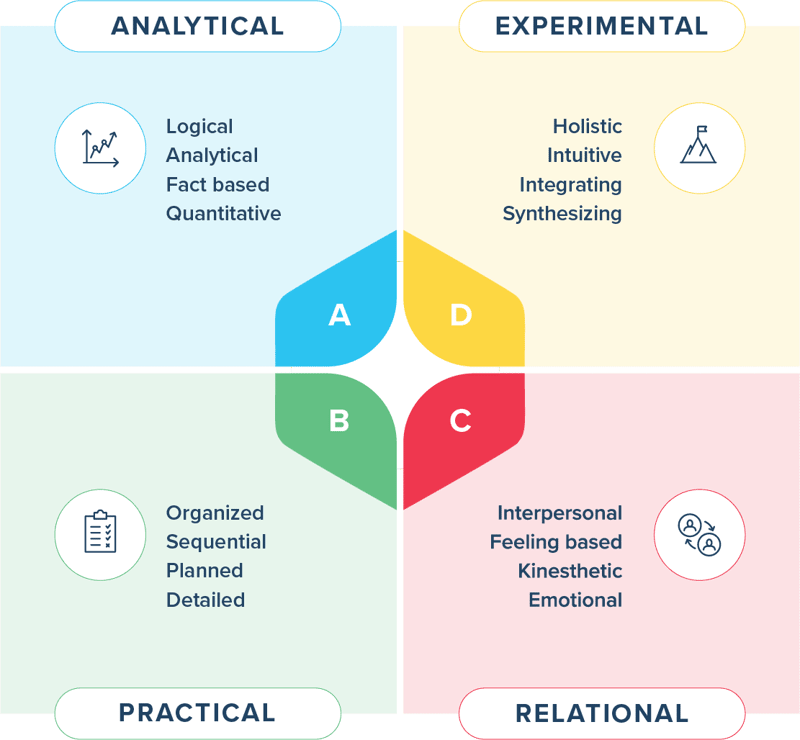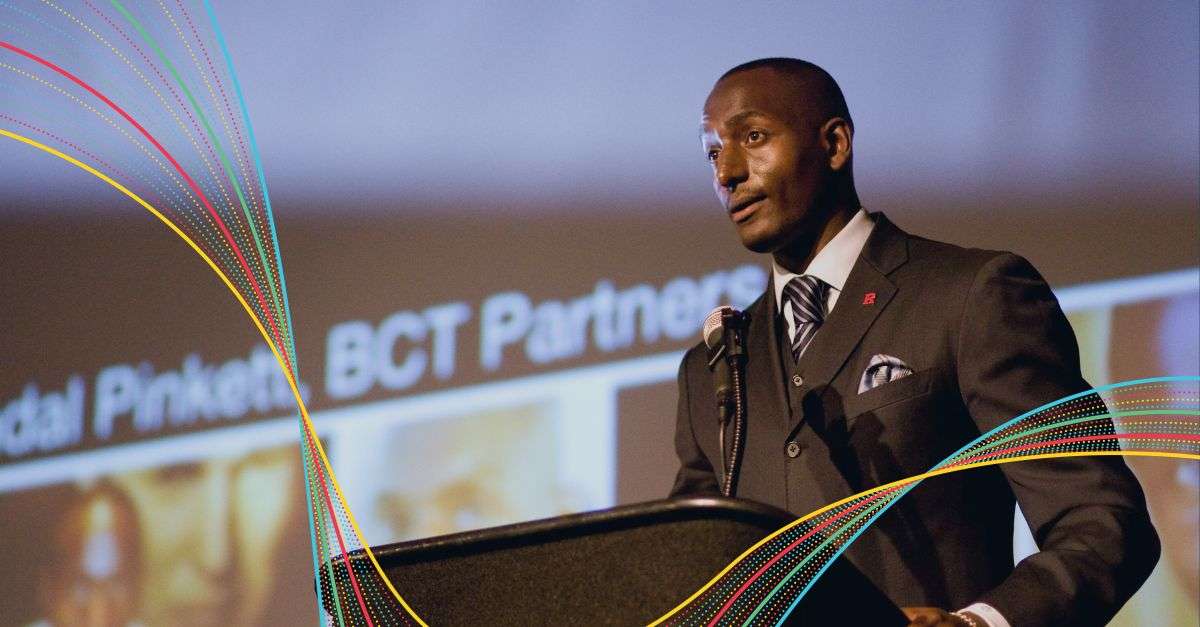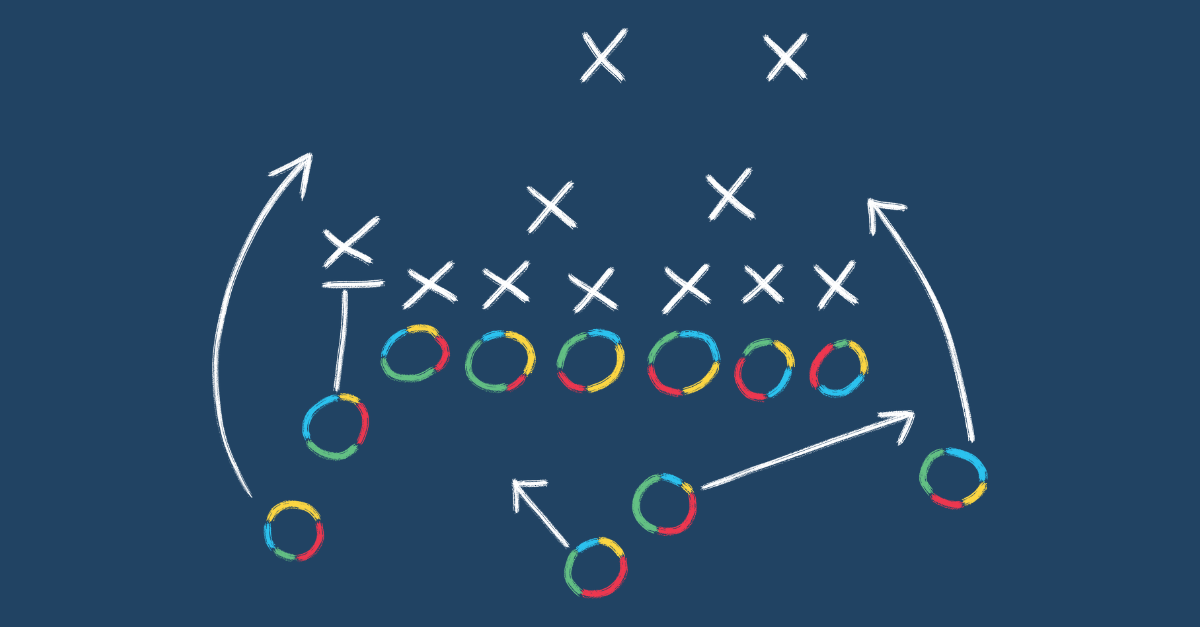Table of Contents |
Assessments help employees to reflect on themselves and others, understand the importance of cognitive diversity, and work together more effectively. However, with many assessments on the market, finding the one that suits your team's needs can be challenging. It's essential to understand the premises supported by the Herrmann Brain Dominance Instrument® (HBDI®) and other assessments. Each of these tools measures different aspects of being human, such as personality, style, strengths, and thinking preferences.
While many assessments align with the HBDI® in measuring thinking preferences, the HBDI® stands out as the only assessment with a methodology or framework that creates a common language. The Whole Brain® Thinking framework generates a reusable baseline language that increases efficiency and understanding across teams, departments, and organizations. The HBDI® assessment is valuable on its own, but its accompanying Whole Brain® Thinking framework provides lasting value and benefits to businesses.
It's essential to explore the foundation of Whole Brain® Thinking and the HBDI® to understand the differences between them and other assessments.
We all have access to Whole Brain® Thinking
Assessments / Tools
What are we measuring?
Assessments / Tools
What are we measuring?
Assessments / Tools
What are we measuring?
Assessments / Tools
What are we measuring?
Assessments / Tools
What are we measuring?
Assessments / Tools
What are we measuring?
Assessments / Tools
What are we measuring?
Assessments / Tools
What are we measuring?
Assessments / Tools
What are we measuring?
Assessments / Tools
What are we measuring?
Assessments / Tools
What are we measuring?
What is the HBDI®?
The HBDI® is the only reliable assessment that is backed by science and helps people decode their thinking-style preferences.
Developed by Ned Herrmann more than 40 years ago, the HBDI® uses the Whole Brain® Thinking Model to assess how people prefer to process information. The assessment operates under the premise that we all have different thinking preferences and can harness those differences to drive innovation and results.
The HBDI® has been used by more than 4 million people worldwide to gain insight into their thinking preferences and that of their colleagues to improve work performance. The HBDI® measures analytical, practical, experimental, and relational thinking styles to determine your team members’ preferences. It provides a blueprint for harnessing cognitive diversity to improve productivity, decision-making, and communication.

The HBDI® provides valuable insight into how people process information so managers can optimize performance by assigning the right tasks to the right people. Knowing each team member’s preferences fosters better communication about thinking in a common language, which enables everyone to work together more effectively.
Because the HBDI® provides insight into how each person processes information, teams and organizations can leverage their collective intelligence for more effective problem-solving and decision-making.
Ultimately, the HBDI® assessment helps individuals better understand themselves and the people around them. It empowers people to reach their full potential while helping teams and organizations achieve greater success through improved collaboration.
What Are the Benefits of Taking the HBDI®?
Taking the HBDI® assessment gives individuals an in-depth look into their thinking patterns. It helps you understand how to apply those preferences in daily interactions, thinking, and work. When you understand your strengths and where you have room for growth, you can consciously develop better strategies for achieving goals, mitigating weaknesses, and leveraging strengths.
Teams benefit from taking the HBDI®, too. Consider the gains individuals take from better understanding their thinking preferences and defaults. Now, magnify those effects by the number of people on your team — and consider how they understand their thinking preferences and have learned about their co-workers’ preferences.
By recognizing, understanding, and embracing their colleagues’ cognitive diversity, your team will begin to work together more effectively and produce better results. The HBDI® assessment can create a common language in the workplace by providing a framework and vocabulary for discussing thinking styles and cognitive preferences. At the highest level, the HBDI® assessment provides a snapshot of your workforce’s cognitive strengths and diversity. With the help of the Herrmann platform, you can access a wealth of insights into decision-making, problem-solving, communication, and creativity across your workforce.
The HBDI® assessment offers a number of potential benefits.
Increased Self-Awareness
HBDI® provides individuals with insights into their preferred thinking styles and cognitive preferences. This self-awareness can help individuals understand how they process information, make decisions, and approach problem-solving. By understanding their thinking preferences, individuals can capitalize on their strengths and develop strategies to compensate for potential blind spots.
Enhanced communication and collaboration
HBDI® can improve communication and collaboration within teams and organizations. When individuals understand their thinking styles and those of others, they can adapt their communication strategies to be more effective. It helps foster understanding and appreciation for different perspectives, improving teamwork and collaboration.
Problem-Solving and Decision-Making
HBDI® can assist in problem-solving and decision-making processes. By understanding their thinking preferences, individuals can approach problems differently and leverage their strengths in specific thinking quadrants. It encourages a more holistic and comprehensive approach to addressing challenges and making informed decisions.
Individual and team development
HBDI® can be used for personal and professional development. It can guide individuals in identifying areas for growth and help them develop strategies to improve their thinking skills in underrepresented quadrants. Similarly, organizations can use HBDI to identify the collective thinking preferences within a team and create development plans to optimize team performance.
Improved Problem-Solving Diversity
HBDI® promotes diversity of thinking styles within teams and organizations. By recognizing and valuing different thinking preferences, organizations can foster a culture that encourages diverse perspectives, leading to more innovative problem-solving and decision-making processes.
How Can You Use the HBDI® in the Workplace?
The greatest value of the HBDI® assessment isn’t the assessment itself. Herrmann’s comprehensive talent intelligence platform provides a system for understanding Whole Brain® Thinking within your workplace and applying the model to drive business results through various tools.
Herrmann’s scalable platform creates a common language around thinking. The Whole Brain® Thinking model spans the organization to connect everyone to your culture, strategy, and processes.
By embedding Whole Brain® Thinking within your existing processes, systems, and workflows, you empower and reinforce each person’s cognitive strengths to carry the business forward through more efficient and effective conversations of trust and understanding.
HBDI® and DiSC
The HBDI® and DiSC assessments are two popular assessments employers use to help team members learn more about themselves. While both assessments help teams discover their strengths and weaknesses (and each other’s), fundamental differences exist.
-
HBDI® measures a person's thinking preferences and has a Whole Brain® Thinking methodology behind it, while DiSC assesses behavior and lacks a comprehensive language or framework for the application.
-
HBDI® focuses on how people process information and make decisions through their thinking preferences, while DiSC looks at behavior without considering thinking processes.
-
DiSC classifies individuals into four profiles based on communication style and reactions to stressors (Dominance, Influence, Steadiness, and Compliance). At the same time, HBDI® has four interconnected quadrants (Logical, Organized, Relational, and Innovative) representing thinking preferences.
-
HBDI® provides a deeper understanding of thinking preferences and offers behavioral clues similar to DiSC reports.
-
Both HBDI® and DiSC provide insights into thought processes and behaviors, enhancing effectiveness at work.
-
HBDI® offers valuable tools and techniques for establishing a shared language and promoting continued utilization beyond the assessment outcomes.
-
Only Whole Brain® Thinking and HBDI® offer a holistic understanding of thinking preferences and provide tools for everyday application, enabling cognitive diversity for improved communication and collaboration at an individual, team, and organizational level.
Learn more about the comparison of HBDI® and DiSC.
HBDI® and CliftonStrengths
The HBDI® and CliftonStrengths (formerly StrengthsFinder) assessments are valuable tools for understanding how people react to challenges and what they gravitate toward in their daily work and interactions.
-
HBDI® measures thinking preferences, while CliftonStrengths identifies natural strengths and highlights areas for development.
-
HBDI® focuses on how people process information and make decisions through the Whole Brain® Thinking Model, which divides thinking into four quadrants.
-
CliftonStrengths measures 324 different strength areas to pinpoint existing skill sets and areas for additional training.
-
Both assessments help individuals and teams improve performance by leveraging natural preferences and abilities.
-
HBDI® provides tools and a common language for applying thinking preferences to improve decision-making, innovation, problem-solving, and communication.
-
CliftonStrengths allows individuals and teams to focus talent in areas aligned with strengths but lacks a comprehensive language or framework for the deeper application.
Learn more about the comparison of HBDI® and CliftonStrengths.
HBDI® and Myers Briggs Type Indicator (MBTI)
The HBDI® and the MBTI can both be used to help teams become more productive. The HBDI® assesses thinking preferences and measures cognitive preferences. Conversely, the MBTI is a personality assessment that categorizes people across four temperaments: extraversion/introversion, sensing/intuition, thinking/feeling, and judging/perceiving.
-
HBDI® measures thinking preferences, while MBTI focuses on personality types.
-
HBDI® is based on the Whole Brain® Thinking model, while MBTI uses four temperament scales.
-
MBTI's complexity and identification of 16 types make it challenging to apply and scale without a comprehensive language or framework.
-
HBDI® provides insight into cognitive preference across the Whole Brain® Thinking quadrants and offers practical application in everyday work activities.
-
MBTI focuses on how personality types interact with others.
-
Both assessments enhance understanding of individual and team strengths and weaknesses.
-
HBDI® provides tools and methodology for creating a common language and supporting ongoing applications beyond assessment results.
Learn more about the comparison of HBDI® and MBTI.
HBDI® and Insights Discovery
The primary difference between HBDI® and Insights Discovery is in the premises. The HBDI® assessment measures a person's thinking preferences. It has a sticky Whole Brain® Thinking mythology behind it, while the Insights Discovery assessment is designed to help individuals understand their personalities and communication style. Like many behavioral assessments, it is more challenging to scale as no easy language or framework supports a deeper application.
-
Insights Discovery uses a four-color model to represent behavioral patterns and adapt communication styles.
-
HBDI® and Insights Discovery can be used together to understand thinking preferences, cognitive preferences, strengths, and behavioral styles.
-
HBDI® helps individuals and teams understand dominant thinking styles for improved problem-solving, communication, and decision-making.
-
Insights Discovery focuses on understanding personalities and communication styles.
-
HBDI® provides tools and methodology for creating a common language and ongoing application.
-
HBDI® offers strategies and recommendations for leveraging thinking preferences.
-
Insights Discovery emphasizes improving interpersonal communication and relationships.
-
HBDI® offers tools and techniques for establishing a shared vocabulary and supporting continued use beyond the evaluation outcomes.
HBDI® and Predictive Index (PI)
Both the HBDI® and PI assessments offer valuable insights into individuals' preferences and behaviors, but they have different scopes, methodologies, and applications. the main difference lies in the focus of the assessments. HBDI® emphasizes thinking preferences and provides a framework for individual and team thinking styles. On the other hand, PI focuses on behavioral drives and provides insights into individual motivations and work preferences, with some limited applicability to team dynamics. Choosing the most suitable assessment depends on the organization's or individual's specific goals and needs.
-
HBDI® measures thinking preferences by analyzing four quadrants of the brain, while PI gauges workplace behaviors and driving forces. Both provide insight into an individual's cognitive and work-related tendencies.
-
HBDI® uses a questionnaire to rate thinking preferences, while PI uses a behavioral assessment framework to analyze responses. Both provide valuable insights for professional work settings.
-
HBDI® helps with personal growth, teamwork, and problem-solving. It identifies cognitive patterns and improves communication. PI aids in talent recruitment, succession planning, and team enhancement. It matches people with suitable positions based on their behavioral traits.
-
HBDI® assesses thinking preferences to boost performance, while PI evaluates work-related behaviors and motivations for better role assignments.
-
HBDI® provides tools and techniques that help establish a common language and encourage their use beyond the evaluation results.
Take Your First Step To Create a Common Language With Whole Brain® Thinking and the HBDI®
Help your talent at all levels of your organization discover their cognitive strengths, thinking preferences, and areas of improvement. Find out how to kick-start Whole Brain® Thinking in your organization.
Schedule a Free Consultation
Your path to a more productive team awaits. Talk to a Whole Brain® expert about your specific challenges to learn how we can help.












